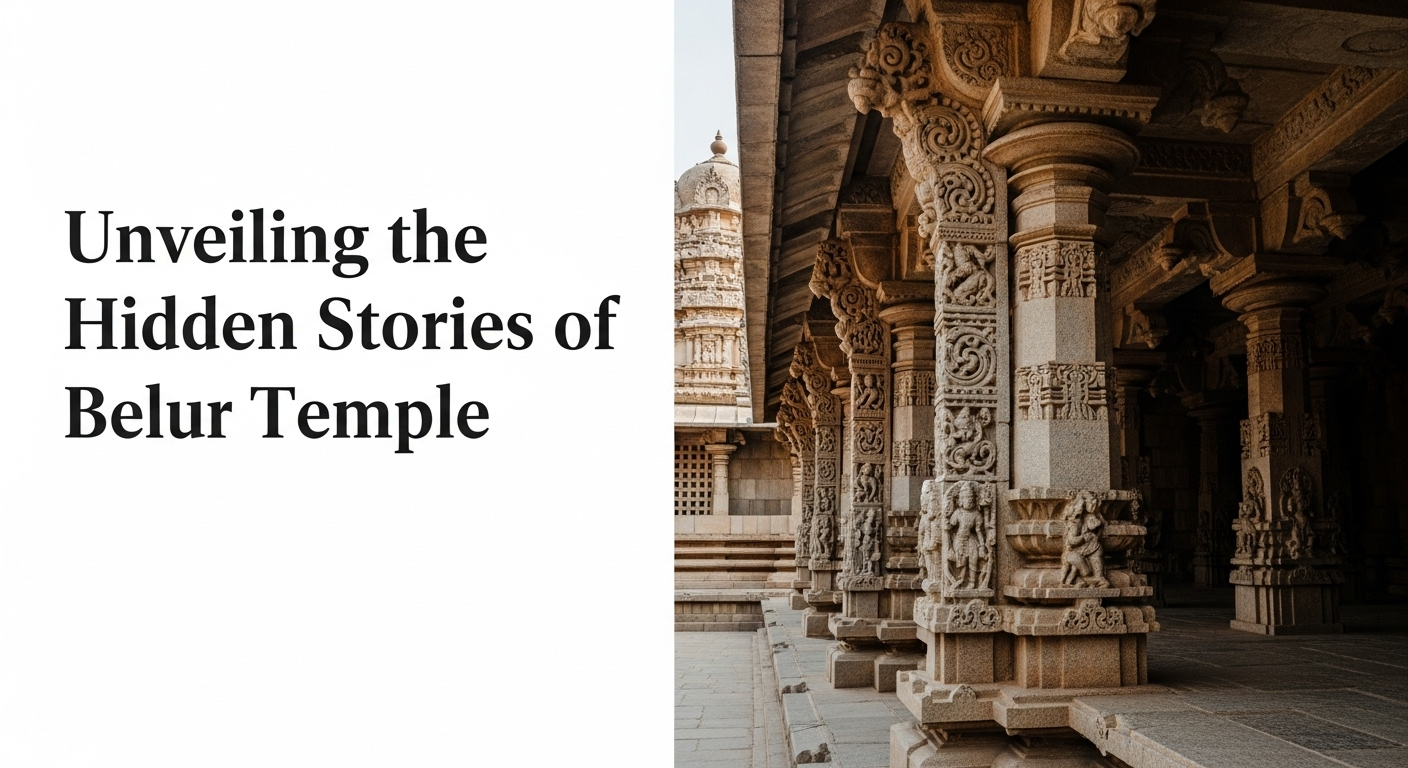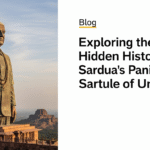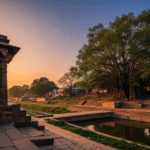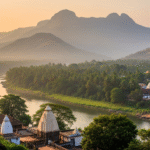The Chennakesava Temple in Belur, Karnataka is more than amazing. It’s a grand display of love and amazing architecture. It’s as stunning as other famous temples and covers a big area. This place isn’t just a tall building. It’s full of stories that are waiting to be told.
It’s a special spot where stone seems to speak. It tells us old tales. This is what makes Belur tourism so rich. Exploring Belur lets you dive into a deep and old heritage.
In Belur, a small place, there’s this huge temple that’s full of history. Visitors can walk through its halls and feel the stories of the Hoysala Empire. Everywhere you look, there are sculptures that show the skill of ancient artists. They’re quietly waiting for people from around the world to admire them.
This temple is at the center of Belur Karnataka. It’s not just a spot for tourists. It’s a sacred journey for anyone wanting to connect with India’s colorful past.
Key Takeaways
- Belur’s Chennakesava Temple is a monumental canvas showcasing the Hoysala Empire’s artistry.
- The hidden stories of Belur are integral to understanding Karnataka’s majestic heritage.
- Belur tourism offers a journey back in time through its stunning architecture and spiritual tradition.
- Engaging with Belur’s history provides insight into the mingling of myth and stone.
- Belur travel guide narratives often miss the deeper stories etched into the temple’s fabric.
- The Chennakesava Temple embodies not just spiritual significance but also historical and cultural density.
The Enchanting History of Belur
The small town of Belur sits in Karnataka. It’s famous for its peaceful views and rich history. The Belur temples show the best of Hoysala Empire’s architecture and culture. They tell us about the area’s important past. Belur’s history is tied with Karnataka’s history. It shows centuries of religious, social, and artistic changes.
The Origin and Significance of Belur Temple
The Belur temples, especially the Chennakeshava Temple, were made to celebrate a big win. They show the power of the Hoysalas after they defeated the Cholas. So, this place is more than a spot for prayers. It’s also a sign of historical victory. Besides its past, the temple is a living place of worship. Every day, rituals and spiritual acts make the temple’s history feel alive. This has been going on for over a thousand years.
Belur Through the Ages: A Timeline of Events
Looking at Belur’s timeline shows its changes and important roles. It started in the 12th century. Despite many challenges and different rulers, Belur’s beauty and spiritual value were kept. It plays a key part in studying South Indian history and Hindu temples.
Here are some important events in Belur’s history:
| Year | Event | Significance |
|---|---|---|
| 1117 AD | Foundation of Chennakeshava Temple | Symbolizes the victory of the Hoysalas over the Cholas |
| 1216 AD | Completion of Temple Carving | Shows the height of Hoysala architectural talent |
| 14th Century | Temple withstands invasions | Belur is seen as a sign of staying strong |
| Modern Era | Recognized as a UNESCO World Heritage Site (Proposal Stage) | Belur is known worldwide |
In short, the story of Belur templе isn’t just about one place. It reflects a bigger tale. It’s about culture and spirituality continuing in Belur, Karnataka.
Exploring the Unique Architecture of Belur
The temples in Belur, Karnataka, show the beauty of Hoysala architecture. They combine spiritual meaning and amazing artistry. The main temple, Chennakesava, is known for its impressive design. Along with other structures, it shows the blend of form that attracts many people.
Belur is known for its special design and use of soapstone. This allows for detailed carvings. These carvings show stories from Hindu texts, daily life, and myths. This makes Belur both an educational and cultural spot. The well-aligned structures and detailed carvings make Belur stand out from other old Indian temples.
The Belur temples have a star-shaped design, typical of Hoysala work. This design adds beauty and more space for sculptures. The temple’s precise geometry and beautiful carvings show the devotion and skill of that time.
Here is a comparison of Belur’s main temple with another important temple in Halebidu. It highlights key architectural features and visitor info:
| Feature | Chennakesava Temple, Belur | Hoysaleswara Temple, Halebidu |
|---|---|---|
| Construction | Early 12th century under King Vishnuvardhana | 12th century |
| Architectural Style | Hoysala architecture; Star-shaped platform | Hoysala architecture; Dual platforms |
| Main Deity | Lord Vishnu as Chennakesava | Lord Shiva |
| Opening Hours | 9:00 AM to 5:30 PM | 6:00 AM to 6:00 PM |
| Festivals Celebrated | Ugadi, Purnima | Maha Shivaratri, Navaratri |
| Entry Fee | Free | Free, photography permitted with permission |
The beauty and details of the Belur temples tell the rich history of Karnataka. They are not just spiritual places but also show the great art and architecture of the past.
The Artistic Brilliance of Belur Sculptures
The Belur Karnataka region is famous for its stone carving tradition. Its sculptures show amazing detail. They capture the culture of their time and the skills of many generations. Looking closely at these sculptures reveals the stories they tell. They show myths and history in a vivid way.
Decoding Sculptural Themes and Motifs
Every sculpture in Belur tells a story. They illustrate tales from ancient texts and local stories. Themes from Hindu epics like the Ramayana and the Mahabharata are common. These artworks display gods in many poses, with myths depicted in great detail. The expressions and decorations reveal deep Indian philosophy and spirituality. They are more than art; they carry India’s unseen heritage.
Masters at Work: The Craftsmen of Belur’s Legacy
The master craftsmen of Belur showed great skill in their sculptures. They chose materials and tools with care. Their work made Belur Karnataka a key cultural place. Today, their art wins praise and inspires artists worldwide.
The art of Belur means more than beauty. It shows the commitment and talent of its makers. Walking through the Chennakesava Temple takes you back in time. It surrounds you with the legacy of artists. Their names may be lost, but their work tells the grand tales of Belur Karnataka’s past.
Hidden Stories of Belur
In the Belur temples, hidden stories whisper through history. They are seldom told. Yet, these tales are the fabric of this holy place’s culture, history, and spirituality.
The Belur carvings capture unique stories. From the devotion of craftsmen to the faith of worshippers, these narratives are often missed. Most focus on Belur’s grand history, overlooking these personal tales.
Daily rituals show the tradition keeping Belur vibrant. The Kedareshwara Temple, 16 km from Belur, showcases Hoysala architecture. It stands as a testament to the area’s strong spiritual roots.
| Detail | Specifics |
|---|---|
| Main Deity | Lord Shiva |
| Key Festivals | Maha Shivaratri, Navaratri, Kartik Purnima, Tamil month of Aadi special prayers |
| Opening Hours | 6:00 AM to 6:00 PM |
| Best Visit Time | October to March |
| Nearby Attractions | Hoysaleswara Temple, Basadi Halli, Archaeological Museum, Belavadi |
The essence of Belur lies in its stories. They show Belur temples as living history. The deities here welcome everyone to share in this divine heritage.
Belur’s charm is in its stories, rituals, and festivals. These layers reveal Belur’s cultural depth. Every visit becomes a deep, meaningful experience.
Exploring Belur is a journey into powerful human tales. It invites us to feel its timeless spirit. Belur’s hidden stories offer a unique way to experience its history.
Belur’s Intricate Carvings: A Deeper Look
Belur is known for its amazing carvings. These have lasted for many years. The Chennakesava Temple is over 900 years old. It has lots of detailed sculptures and carvings. This shows the art and culture of ancient India very well.
The carvings in Belur and the temple complex took 103 years to finish. They show strong religious beliefs and love for art. The detailed work shows how skilled the artists were. They could make stone seem alive. This tells us a lot about Belur’s art.
The Language of Stone: Understanding Carvings
The temple walls have many sculptures. They tell stories from Indian epics like the Mahabharata and Ramayana. This makes the temple a place full of myths. Every corner has tales from the past, brought to life with great skill.
The temple has 42 madanikas or celestial nymphs. They are in different poses. They have 620 different hairstyles. This shows how much attention the artists paid to details.
Mythology Carved in Time: Main Sculptures and their Meanings
The carvings show the culture and religion of the time. The base of the monument has 644 elephant carvings. They stand for stability and strength. A 36-foot high pillar is also inside the temple. It weighs 16,000 kg and shows Belur’s architectural skill.
The Hindu epics’ carvings serve as spiritual guideposts. They attract scholars and tourists. Each carving shows traditions that have been captured in stone. They make people curious for many years.
Belur’s sculptures have been on the tentative UNESCO World Heritage list since 2014. They attract visitors and teach about Indian art and architecture.
The Role of Belur in Karnataka’s Culture
Belur is a small town in Karnataka’s Hassan district. It’s not just a place to visit. It tells the story of the area’s rich past. Belur’s carvings and buildings show the town’s deep culture and spirituality.

Belur’s past is linked with Karnataka’s story. The Chennakesava Temple here is a marvel of Hoysala architecture from the 12th century. This temple draws people worldwide. It’s also key for studying ancient Indian art.
Belur shapes Karnataka’s culture deeply. It’s known for its architecture, dance, music, and festivals. The Chennakesava Temple’s Rathotsava brings people together. It celebrates long-standing traditions.
The town’s temples have daily rituals. These practices show Belur’s spiritual history. They give a look into sacred customs kept alive for centuries.
Belur is famous for its food too. Dishes like Bisi Bele Bath and Mysore Pak connect the old and new. They tell tales of the local farming life and food creativity.
The Yagachi Dam near Belur offers fun on the water. It makes the town even more interesting as a cultural center.
Belur is key to understanding Karnataka’s culture. Its temples, festivals, and beauty add much to Indian heritage. Belur continues to shape its region’s cultural identity, showing its lasting importance.
Ceremonies and Rituals: The Living Traditions of Belur
The ceremonies and rituals in Belur’s temples are important. They connect the past and present. They show Belur Karnataka’s spirit, attracting many to Belur tourism.
Each ceremony and ritual at Belur temples is amazing. They bring history and devotion together. Annual festivals are special, drawing people from everywhere.
Annual Festivals and Their Historical Roots
Durga Puja at Belur Math started in 1901 by Swami Vivekananda. It was a big spiritual event. The first celebration on October 18, 1901, brought many people together.
This festival brings the community together. It goes beyond caste and religion. It’s a key event for Belur.
Daily Rites: Keeping the Spiritual Flame Alive
The daily rites at Belur temples show deep spiritual commitment. These practices maintain the divine’s presence. Morning prayers to evening aartis are vital for Belur’s spiritual life.
Belur is a window to rich stories and spiritual sights. It’s known for big festivals and daily rituals. Belur is a symbol of cultural strength and spiritual purity today.
Unseen Corners: Off-The-Beaten-Path Spots in Belur Temple
Belur Temple is famous for its amazing architecture and detailed sculptures. But it also has hidden spots not many know about. These places offer a peek into Belur’s rich history and cultural importance. They add to Belur’s allure. They give a peaceful and reflective experience away from the main attractions.
These quiet areas within the temple aren’t just for silence. They are full of stories. Every corner of Belur Temple holds history. It shares secrets of spiritual practices and ancient rites passed down through generations.
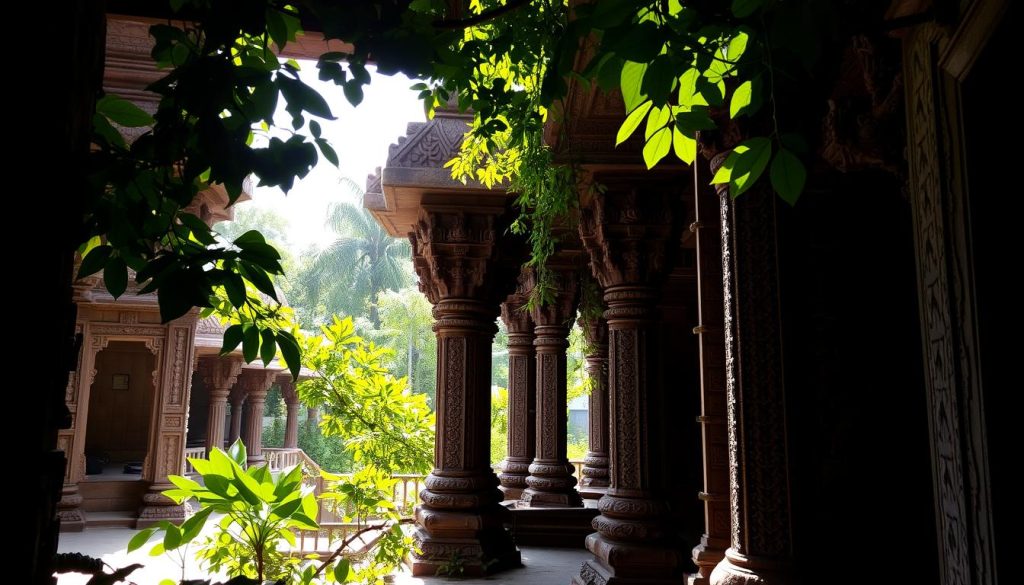
The less noticed parts of the temple are key to understanding Belur’s heritage. They give a closer look at the past. This allows visitors to think about the spiritual and historic sides of what they see.
| Location | Feature | Significance |
|---|---|---|
| North Cloister | Lesser-known carvings | Insights into the daily lives of ancient artisans |
| Western Corridor | Old inscriptions | Depicts the evolution of script and language in Belur history |
| South Garden | Forgotten sculptures | Displays a blend of architectural styles over different eras |
| Eastern Pavilion | Secluded meditation spots | Used for personal spiritual practices away from the main temple activity |
Exploring these hidden spots in Belur Temple makes your visit richer. It also helps understand and appreciate Belur’s history and spirituality better. If you’re into the full history and deep spiritual insights of Belur, don’t miss these spots.
Preservation Efforts and Challenges
Keeping the Belur Temple safe is very important. It needs the help of both old and new ways to keep its culture and history alive. Just like the teachings of Ramakrishna still inspire us today, Belur’s heritage needs the same care and new ideas for fixing and keeping it safe.
The Conservation and Restoration of Belur Temple
To fix and keep the temple safe, we use methods that care for its structure and beauty. This means respecting the temple’s original art while using new technology. This method follows the example of saving old texts like Sri Sri Ramakrishna Kathamrita.
Battling Time and Elements: Protecting Belur’s Heritage
Protecting Belur is hard because of the weather and people. The work done at the Belur Math by the Ramakrishna Order shows how important it is to keep protecting Belur. This hard work lets future kids see Belur’s beauty and feel its spirit.
| Belur Conservation Priority | Relevant Approach | Example from Historical Preservation |
|---|---|---|
| Structural Integrity | Use of traditional construction methods combined with modern engineering | Restoration techniques employed at Belur Math |
| Aesthetic Preservation | Meticulous restoration of carvings and sculptures | Artwork conservation in Sri Sri Ramakrishna Kathamrita |
| Environmental Protection | Implementation of weather-proofing and pollution control measures | Environment control initiatives at Belur Math |
Conclusion
Exploring the hidden stories of Belur shows us India’s rich spirit, amazing buildings, and deep culture. Nearby, the Kedareshwara Temple showcases Hoysala architecture. It has a unique star shape and detailed pillars. These show the high skill of ancient artisans, which still amazes us today.
The temple is open from dawn to dusk. Visitors can see Aarti ceremonies in the morning and evening. They make the place feel more holy. The cooler months, from October to March, are the best for a visit. This is when you can enjoy big festivals like Maha Shivaratri and Navaratri.
Our journey has been more than just visiting a special place. It’s like traveling through time. We’ve gone from the lessons of Ramakrishna to today’s visits. Telling these stories lets us share Belur’s beauty and importance. This place, full of history, art, and effort, invites us all to see it with our own eyes.
FAQ
What are some of the hidden stories of Belur Temple?
Belur Temple has hidden stories about its creators, the insights of artisans, and the devotion of its worshippers. These stories are found in its carvings and local tales. Exploring them helps us appreciate the temple’s deep cultural story.
Can you explain the historical significance of Belur Temple?
The history of Belur Temple is important. It shows the high point of Hoysala architecture. It also reflects the religious and cultural changes in Karnataka during the Hoysala Empire. It helps us understand the region’s lasting spiritual heritage.
How is Belur’s unique architecture characterized?
The architecture of Belur is known for its detailed designs and advanced building methods. Its beauty combines spiritual meaning with visual appeal. It has detailed carvings and balanced designs that show the skillful architecture of the Hoysala period.
What kinds of motifs can be found in the sculptures of Belur?
Belur’s sculptures are decorated with many motifs. These include stories from mythology, images of deities, epic scenes, and nature. They show India’s religious, philosophical, and cultural beliefs.
Who were the craftsmen behind Belur’s legacy, and what was their influence?
The creators of Belur’s wonders were talented Hoysala artisans. Their skill in sculpture and art left a lasting impact. Even though we don’t know their names, their work adds greatly to India’s cultural and artistic heritage.
What insights can be gained from Belur’s intricate carvings?
Belur’s carvings offer a glimpse into ancient Indian life, myths, social setups, and cultures. Each carving shows detailed work and symbolism. They help us understand historic stories better.
How does Belur contribute to Karnataka’s culture?
Belur plays a big part in Karnataka’s culture. It captures the artistic, spiritual, and historical spirit of the area. The temple’s practices, craftsmanship, and stories are key to Karnataka’s cultural identity. They influence the language, traditions, and regional pride.
What are the annual festivals celebrated at Belur and their historical roots?
Belur’s festivals, like the grand Chariot Festival, come from old traditions. These festivals show the temple’s cultural and spiritual importance to locals and visitors.
What daily rites are performed at Belur Temple?
Belur Temple’s daily practices include offerings, prayers, and ceremonies by priests. These are done with great care to keep the temple’s spiritual heart and traditions alive.
What lesser-known spots can visitors explore within Belur Temple?
Within Belur Temple, visitors can find hidden spots. These include quiet courtyards, small shrines, and secret corners. These spots offer a closer look at Belur’s history and spiritual feel.
What are the challenges faced in the preservation of Belur Temple?
Preserving Belur Temple is tough. It faces issues like environmental damage, structural wear, and balancing visitor needs with conservation. Keeping the temple’s detailed art safe needs restoration skills and ongoing care.
How can one contribute to the preservation and protection of Belur’s heritage?
To help preserve Belur’s heritage, one can support local preservation efforts and raise awareness of the temple’s importance. Responsible visiting is crucial to limit harm to the structure and surroundings.
